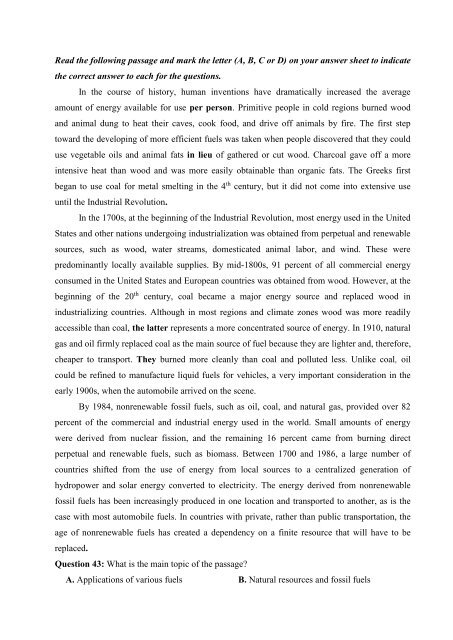Bộ đề thi thử THPTQG năm 2018 - Môn Tiếng Anh - 20 ĐỀ + ĐÁP ÁN - GV Kiều Thị Thắng - Tuyensinh247
https://app.box.com/s/fdml0d4t6lk8t30qzh0xow50qpjgs63c
https://app.box.com/s/fdml0d4t6lk8t30qzh0xow50qpjgs63c
Create successful ePaper yourself
Turn your PDF publications into a flip-book with our unique Google optimized e-Paper software.
Read the following passage and mark the letter (A, B, C or D) on your answer sheet to indicate<br />
the correct answer to each for the questions.<br />
In the course of history, human inventions have dramatically increased the average<br />
amount of energy available for use per person. Primitive people in cold regions burned wood<br />
and animal dung to heat their caves, cook food, and drive off animals by fire. The first step<br />
toward the developing of more efficient fuels was taken when people discovered that they could<br />
use vegetable oils and animal fats in lieu of gathered or cut wood. Charcoal gave off a more<br />
intensive heat than wood and was more easily obtainable than organic fats. The Greeks first<br />
began to use coal for metal smelting in the 4 th century, but it did not come into extensive use<br />
until the Industrial Revolution.<br />
In the 1700s, at the beginning of the Industrial Revolution, most energy used in the United<br />
States and other nations undergoing industrialization was obtained from perpetual and renewable<br />
sources, such as wood, water streams, domesticated animal labor, and wind. These were<br />
predominantly locally available supplies. By mid-1800s, 91 percent of all commercial energy<br />
consumed in the United States and European countries was obtained from wood. However, at the<br />
beginning of the <strong>20</strong> th century, coal became a major energy source and replaced wood in<br />
industrializing countries. Although in most regions and climate zones wood was more readily<br />
accessible than coal, the latter represents a more concentrated source of energy. In 1910, natural<br />
gas and oil firmly replaced coal as the main source of fuel because they are lighter and, therefore,<br />
cheaper to transport. They burned more cleanly than coal and polluted less. Unlike coal, oil<br />
could be refined to manufacture liquid fuels for vehicles, a very important consideration in the<br />
early 1900s, when the automobile arrived on the scene.<br />
By 1984, nonrenewable fossil fuels, such as oil, coal, and natural gas, provided over 82<br />
percent of the commercial and industrial energy used in the world. Small amounts of energy<br />
were derived from nuclear fission, and the remaining 16 percent came from burning direct<br />
perpetual and renewable fuels, such as biomass. Between 1700 and 1986, a large number of<br />
countries shifted from the use of energy from local sources to a centralized generation of<br />
hydropower and solar energy converted to electricity. The energy derived from nonrenewable<br />
fossil fuels has been increasingly produced in one location and transported to another, as is the<br />
case with most automobile fuels. In countries with private, rather than public transportation, the<br />
age of nonrenewable fuels has created a dependency on a finite resource that will have to be<br />
replaced.<br />
Question 43: What is the main topic of the passage?<br />
A. Applications of various fuels B. Natural resources and fossil fuels


















